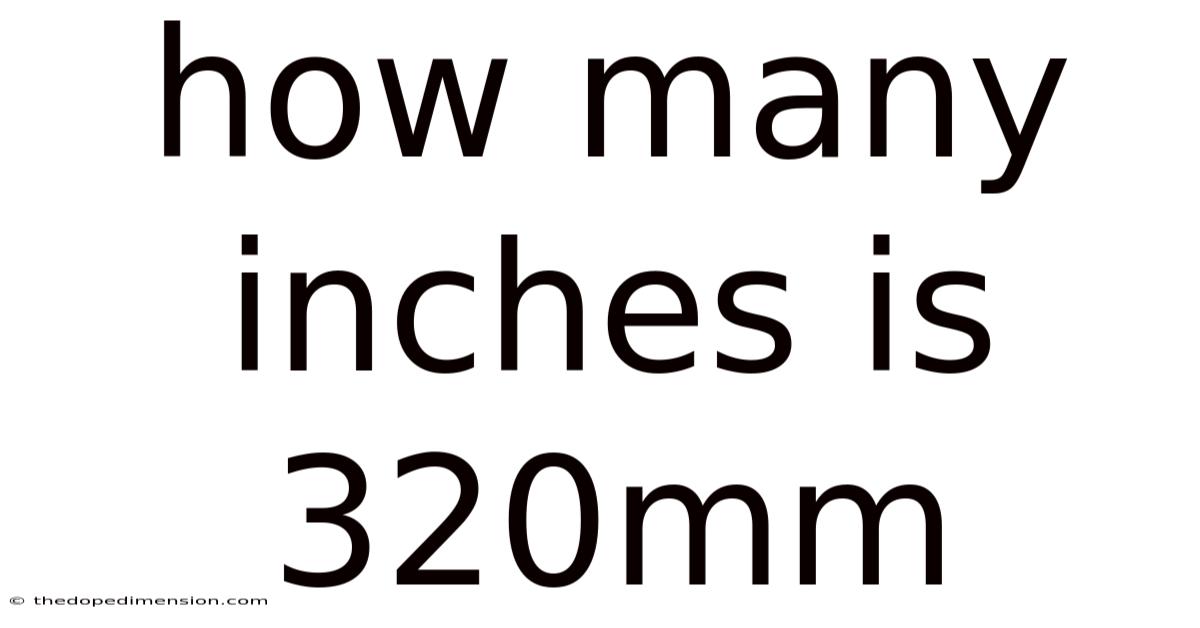How Many Inches Is 320mm
thedopedimension
Sep 08, 2025 · 4 min read

Table of Contents
How Many Inches is 320mm? A Comprehensive Guide to Metric-Imperial Conversion
Understanding the relationship between metric and imperial units is crucial in many fields, from engineering and manufacturing to everyday life. This article will comprehensively explore the conversion of 320 millimeters (mm) to inches (in), providing not just the answer but a deeper understanding of the conversion process and its applications. We'll cover the calculation, explore the underlying principles, delve into practical examples, and address frequently asked questions. This guide aims to equip you with the knowledge and confidence to handle similar conversions independently.
Introduction: The Metric and Imperial Systems
The world uses two primary systems of measurement: the metric system (also known as the International System of Units or SI) and the imperial system (or US customary units). The metric system, based on powers of 10, is predominantly used globally for its simplicity and consistency. The imperial system, on the other hand, uses a more complex and less standardized set of units, with its origins rooted in ancient practices. Understanding the differences and how to convert between them is essential for seamless communication and collaboration across international boundaries.
Converting 320mm to Inches: The Calculation
The fundamental conversion factor between millimeters and inches is:
- 1 inch = 25.4 millimeters
To convert 320mm to inches, we can use the following formula:
Inches = Millimeters / 25.4
Substituting 320mm into the formula:
Inches = 320mm / 25.4mm/in ≈ 12.598 inches
Therefore, 320 millimeters is approximately equal to 12.6 inches. Rounding to one decimal place is generally sufficient for most practical purposes.
Understanding the Conversion Process: A Deeper Dive
The conversion factor (25.4 mm/in) is derived from the precise definition of the inch in terms of the meter, the fundamental unit of length in the metric system. This ensures consistency and accuracy in conversions. The process involves a simple division, effectively determining how many times the length of one inch (25.4mm) fits into the given length of 320mm.
Practical Applications: Where This Conversion is Useful
The conversion of millimeters to inches finds application in numerous scenarios:
- Engineering and Manufacturing: Many blueprints and technical specifications use both metric and imperial units. Accurate conversion is essential to ensure components fit together correctly.
- Construction and Building: Construction projects often involve materials and tools from different manufacturers, potentially using different measurement systems.
- Design and Drafting: Design software allows for input in both systems, but accurate conversion is still necessary for precise design and output.
- Everyday Life: While less common than in professional contexts, situations may arise where converting between millimeters and inches is helpful (e.g., measuring the screen size of a device).
Beyond the Calculation: Working with Different Units
While this article focuses on converting 320mm to inches, the underlying principles can be applied to other metric-imperial conversions. For example:
- Converting centimeters (cm) to inches: Since 1 cm = 10 mm, you can first convert cm to mm and then use the conversion factor above.
- Converting meters (m) to feet (ft) or yards (yd): This involves a slightly more complex conversion, requiring multiple steps and potentially different conversion factors.
- Converting millimeters to feet: Requires a two-step conversion, first converting millimeters to inches and then inches to feet (1 foot = 12 inches).
Frequently Asked Questions (FAQ)
Q: Is 12.6 inches exactly equal to 320mm?
A: No, it's an approximation. The exact value is 12.59842519685 inches, but rounding to one or two decimal places is generally sufficient for practical applications.
Q: What is the difference between mm and in?
A: "mm" stands for millimeters, a unit of length in the metric system. "in" stands for inches, a unit of length in the imperial system. The difference lies in the base unit and the scale used for measurement.
Q: Why are there two different systems of measurement?
A: The metric system was developed later and offers advantages in consistency and ease of use due to its decimal base. The imperial system evolved over centuries and is still in use in some countries, primarily the United States.
Q: Are there online converters for mm to inches?
A: Yes, many websites and applications offer online converters for metric-imperial conversions. These can be helpful for quick conversions but understanding the underlying principles is crucial for more complex situations.
Q: What if I need to convert a larger or smaller measurement?
A: The same formula (Inches = Millimeters / 25.4) applies regardless of the size of the measurement. Simply substitute the given millimeter value into the formula.
Conclusion: Mastering Metric-Imperial Conversions
Converting 320mm to inches, approximately 12.6 inches, is a straightforward process once you understand the fundamental conversion factor. This article has provided not just the answer but also a deeper understanding of the underlying principles, practical applications, and frequently asked questions. By mastering these conversions, you'll be better equipped to navigate various situations requiring proficiency in both metric and imperial units, fostering clearer communication and improved accuracy in various professional and everyday scenarios. Remember the key conversion factor: 1 inch = 25.4 millimeters, and you'll be well on your way to confident metric-imperial conversions. Practice makes perfect, so try converting other measurements to solidify your understanding.
Latest Posts
Latest Posts
-
Convert 135 Cm To Inches
Sep 08, 2025
-
How To Pounds To Kilograms
Sep 08, 2025
-
Fluid Oz To Quart Conversion
Sep 08, 2025
-
Mph To Feet Per Hour
Sep 08, 2025
-
6 534 Sqft To Acres
Sep 08, 2025
Related Post
Thank you for visiting our website which covers about How Many Inches Is 320mm . We hope the information provided has been useful to you. Feel free to contact us if you have any questions or need further assistance. See you next time and don't miss to bookmark.